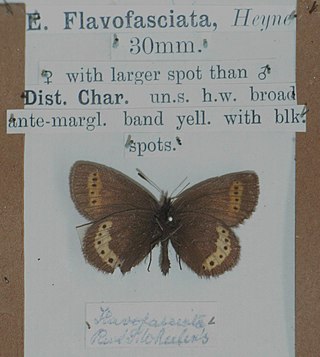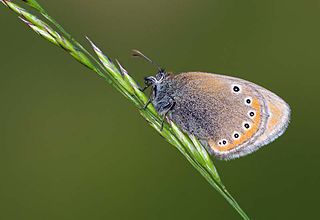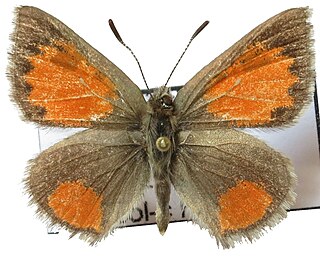
Anthocharis gruneri is a butterfly found mainly in Turkey, Transcaucasian Mountains, Asia Minor and the Armenian highlands.

Aporia crataegi, the black-veined white, is a large butterfly of the family Pieridae. A. crataegi is widespread and common. Its range extends from northwest Africa in the west to Transcaucasia and across the Palearctic to Siberia and Japan in the east. In the south, it is found in Turkey, Cyprus, Israel, Lebanon and Syria. It is not usually present in the British Isles or northern Scandinavia.

Melitaea diamina, the false heath fritillary, is a butterfly of the family Nymphalidae.

The scarce copper is a butterfly of the family Lycaenidae.

Parnassius eversmanni, or Eversmann's parnassian, is a high-altitude butterfly which is found in eastern Russia, Mongolia, Japan, Alaska, and the Yukon. It is a member of the snow Apollo genus (Parnassius) of the swallowtail family, Papilionidae. The species was named to honour Eduard Friedrich Eversmann.

Lasiommata maera, the large wall brown, is a butterfly in the family Nymphalidae.

The Piedmont ringlet is a member of the family Nymphalidae. It is an Alpine butterfly.

The yellow-banded ringlet is a member of the subfamily Satyrinae of the family Nymphalidae. It is a high mountain butterfly found in a small area of the Alps in Switzerland and Italy.

Tomares ballus, the Provence hairstreak or cardenillo, is a butterfly of the family Lycaenidae. It is found on the Iberian Peninsula, northern Africa and along the Mediterranean coast of France.

Pseudophilotes baton, the baton blue, is a butterfly of the family Lycaenidae. It is found in central and southern Europe and then east across the Palearctic to the Russian Far East.

Polyommatus daphnis, the Meleager's blue, is a butterfly of the family Lycaenidae.

Boloria pales, the shepherd's fritillary, is a butterfly of the family Nymphalidae. It is found from the Cantabrian Mountains and the Pyrenees through the Alps and Apennine Mountains east to the Balkan, Carpathian Mountains, the Caucasus and central Asia up to western China.

Muschampia tessellum, the tessellated skipper, is a butterfly of the family Hesperiidae. It is found from the southern Balkan Peninsula through Ukraine, southern Russia and Asia Minor, southern Siberia, Mongolia, east to the Amur region.

Polyommatus (Plebicula) dorylas, the turquoise blue, is a butterfly of the family Lycaenidae. It is found in southern Europe, Asia Minor, the Ural Mountains, Caucasus and Transcaucasia. Its wingspan is 15–17 mm. The butterfly's common name comes from the dazzling bright blue colour of male's wings. The larvae feed on Anthyllis vulneraria. The butterfly flies from May to September in two generations. Habitats include flowery meadows in rocky areas at 500–2000 m.

Arethusana is a butterfly genus from the subfamily Satyrinae of the brush-footed butterfly family (Nymphalidae). It is composed of only one species, Arethusana arethusa, the false grayling.

Aricia anteros, the blue argus, is a European butterfly in the family Lycaenidae. It has a wingspan of 30–34 mm. In Europe it can be found in Macedonia, Albania, Greece, Bulgaria, Serbia, Croatia, Montenegro, Bosnia and Herzegovina, Romania, Ukraine and in Turkey. Its primary larval food plants are Geranium sanguineum and Geranium macrorrhizum.

Coenonympha leander, the Russian heath, is a butterfly belonging to the family Nymphalidae. It is found in northern Greece, Hungary, Bulgaria, southern Russia, Asia Minor, Armenia and Iran. The habitat consists of warm grassy areas.

Tomares callimachus, the Caucasian vernal copper, is a butterfly of the family Lycaenidae. It is found in Anatolia, Iraq, Iran, the Caucasus, and Transcaucasia.

Euphydryas intermedia synonym ichnea is a small butterfly found in the Palearctic that belongs to the browns family. It occurs up to 2200 m above sea level.

Erebia maurisius is a butterfly found in the East Palearctic that belongs to the browns family.






















